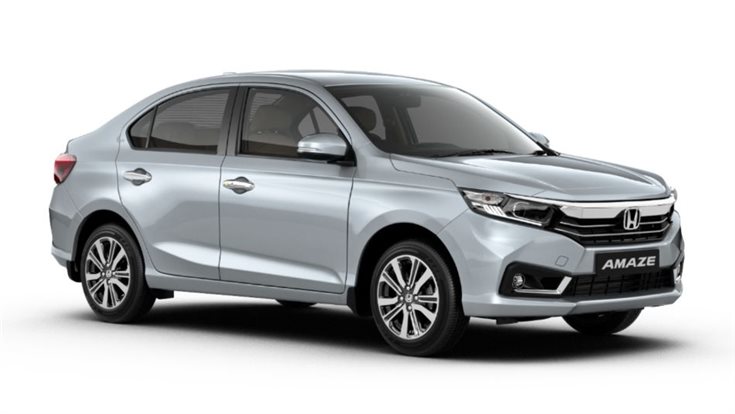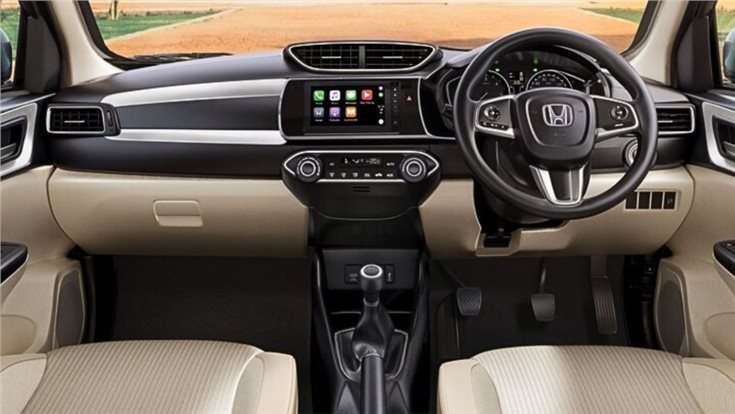New Amaze wears an all-new skin inside out, but remains mechanically unchanged.
Honda recently launched the all-new Amaze with prices ranging between Rs 8.00 lakh and Rs 10.90 lakh (ex-showroom, India). The new Amaze sees a marked departure from its predecessor in terms of design, interior and features, but remains mechanically unchanged under the skin. It has adopted a new family look both on the inside and the outside inspired by the City and Elevate, and has gained a lot on the equipment front as well. Here, we are taking a close look at how the new Honda Amaze has evolved over its predecessor.
Honda Amaze new vs old exterior design
With an Elevate-like fascia, the new Amaze looks a lot more coherent and cleaner than the previous generation sedan which had a very busy face with multiple layers and trims with edgy contouring. The grille is much larger, the headlamps are sleeker and there’s much lesser use of chrome as well. The face also appears more upright than the slightly bowing stance of older Amaze, and overall, its more mature and modern.
Honda Amaze front quarter
In profile, at first glance, very little seems to have changed. Even the doors and window line look near identical on both models. However, a closer look reveals slightly sharper character lines running across the length of the new Amaze, and the main differentiator are, of course, the new 15-inch dual-tone alloys. The new Amaze also gets slightly more pronounced wheel arches, and the wing mirror has been relocated from the pillar to the door.
The rear-end of the Amaze is clearly inspired by the City. This brings with it sleek, rectangular tail lamps as opposed to the bulbous, asymmetrical units on the older Amaze, and it also gets a single-tone finish for the bumper instead of a dual-tone finish with a chrome trim.
Honda Amaze rear quarter
In terms of dimensions, the length, height, and wheelbase remain identical at 3,995m, 2,470mm and 1,500mm, respectively. However, the new Amaze has grown slightly wider by 38mm, and boot space has gone down by 4-litres.
Honda Amaze new vs old interior and features
Just like the exterior, the interior of the new Amaze also sees a complete overhaul. Here too, it shares a lot with the Elevate SUV with a very clean and layered design. The touchscreen is now a free-standing unit instead of being integrated in the dashboard, the AC vents have moved below it and the steering wheel is a chunkier unit with new buttons for added functionality.
Honda Amaze interior
The new Amaze continues with a dual-tone black and beige theme for the interior, but there’s a new textured trim on the dashboard incorporating the AC vents as opposed to the silver garnishes on the previous model. There’s also a nifty new wireless charging shelf in the centre console area and it also gets a new 7-inch digital MID for the instrument cluster in place of an analogue dial for the tachometer.
Other notable equipment upgrades include a new ADAS suite, lane watch camera, six airbags as standard and new rear AC vents.
Honda Amaze new vs old engine, specs
This is one area where the new Amaze has remained completely unchanged. The new Amaze continues with the familiar 1.2-litre, four-cylinder petrol engine that still produces 90hp and 110Nm of torque. Transmission options continue to be a 5-speed manual or a CVT automatic, but the latter now gets paddle shifters for some manual control.
Honda Amaze side profile
Honda claims a fuel efficiency of 18.65kpl for the manual variant, while the CVT automatic returns 19.46kpl. While the manual variants remain just as efficient as before, the automatic variant is now 1.16kpl more efficient than its predecessor.
The new Honda Amaze continues to rival the Maruti Dzire, Hyundai Aura and the Tata Tigor. Do you think Honda has done enough to differentiate the new Amaze from its predecessor, or do think they could have done more? Let us know in the comments below.
Also See:
New Honda Amaze variant-wise features, colours, explained
Maruti Dzire CNG vs rivals: specs, mileage, features and price compared









